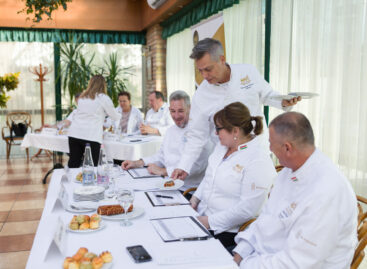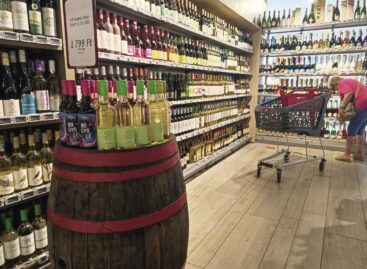Good cakes are not a luxury – what makes the pastry profession viable today?
Rising ingredient prices, labour shortages, burdensome regulations – yet customers still expect to find fresh, high-quality cakes at reasonable prices in Hungarian confectioneries. According to Balázs Erdélyi, President of the Hungarian Confectioners Guild, this expectation is not unreasonable – provided that dedicated professionals stand behind the counter.
 “Inflation, operating costs, and excessive bureaucracy are all major challenges, but this year, the weather has been our greatest adversary,” says Erdélyi. Spring – traditionally the start of the ice cream season – was a no-show, which significantly reduced sales. Still, he believes that with the arrival of good weather, customers will return – and with them, the hope that artisanal confectionery can not only survive but also thrive.
“Inflation, operating costs, and excessive bureaucracy are all major challenges, but this year, the weather has been our greatest adversary,” says Erdélyi. Spring – traditionally the start of the ice cream season – was a no-show, which significantly reduced sales. Still, he believes that with the arrival of good weather, customers will return – and with them, the hope that artisanal confectionery can not only survive but also thrive.
What Should We Expect from a Dessert Today?
Today, a slice of cake typically costs between 1,000 and 1,500 forints, with premium desserts going well above 2,000. But what do we get for that price? Erdélyi believes expectations shouldn’t depend on the price, but rather on the ingredients and the preparation method. “A simpler, cheaper dessert can still be decent and delicious, while more expensive ones should rightfully offer top-quality ingredients and refined presentation.”
Artisanal Quality Means Local Ingredients and Genuine Flavour
Good desserts begin with good ingredients – and with bakers who love their craft. Erdélyi highlights the growing importance of working directly with local producers. Many confectioners now purchase their ingredients from Hungarian farmers, creating unique flavours and strengthening the local economy. Although not everything can be sourced domestically, the key is to find high-quality, natural ingredients – even if they come at a higher price.
Home Baking vs. Professional Confectioneries
While many still favour “homemade” desserts, Erdélyi warns that such products are often made in unlicensed and unregulated conditions. “These cakes are only cheaper because they bypass taxes and regulations,” he notes. During the pandemic, such home bakers proliferated, but from a food safety perspective, Erdélyi firmly recommends official bakeries – many of which also offer traditional ‘home-style’ cakes.
Is It Worth Becoming a Confectioner Today?
Absolutely – the profession has been facing a labour shortage for years, and skilled professionals are in high demand. Unfortunately, most graduates leave the field: “Eight or nine out of ten don’t stay in the trade,” Erdélyi laments. The Guild now offers training programs for instructors, helping them stay up to date and support the next generation of confectioners. “Those who are truly committed leave school with strong foundations.”
Starting a Business: Dream or Obstacle Course?
Many aspiring confectioners dream of opening their own business – but it’s far from easy. The costs are high, the market is saturated, and support is limited. “Being a good baker is not the same as running a business successfully,” Erdélyi warns. “This is a wonderful profession – but also an expensive hobby,” he adds, quoting a seasoned colleague.
Balaton Ice Cream of the Year 2025: Goat Cheese with a Twist
This year’s winner of the “Balaton Ice Cream of the Year” competition proves just how creative Hungarian artisans can be. The champion creation, “MEKKóstollak”, featured goat cheese from a local producer, spiced pear sauce, rosemary, and salted almonds. Even Erdélyi, not a fan of goat cheese, ranked it highly. “These kinds of local, bold creations embody what this competition is all about,” he says.
Albanian-Style Ice Creams on the Rise – Should We Be Worried?
Price and quality now vary wildly, with scoop prices ranging from 550 to 850 forints. Some vendors offer low prices simply to attract customers, even using last year’s pricing. But colourfully artificial ice creams with towering scoops and little real content raise concerns. “If it’s under 500 forints, be suspicious,” says Erdélyi. “These often contain more colourants and additives than actual ingredients.”
Still, he believes educated consumers will increasingly seek value over volume. “Once someone tastes a genuine, high-quality Hungarian ice cream, they won’t go back to the fake stuff.”
Related news
Dessert of Lake Balaton
🎧 Hallgasd a cikket: Lejátszás Szünet Folytatás Leállítás Nyelv: Auto…
Read more >Íme, Az Év Bejglije 2025. verseny eredményei
🎧 Hallgasd a cikket: Lejátszás Szünet Folytatás Leállítás Nyelv: Auto…
Read more >We took you on a flight! (Part 1)
🎧 Hallgasd a cikket: Lejátszás Szünet Folytatás Leállítás Nyelv: Auto…
Read more >Related news
AI Governance – competitive edge or risk?
🎧 Hallgasd a cikket: Lejátszás Szünet Folytatás Leállítás Nyelv: Auto…
Read more >Dessert of Lake Balaton
🎧 Hallgasd a cikket: Lejátszás Szünet Folytatás Leállítás Nyelv: Auto…
Read more >





